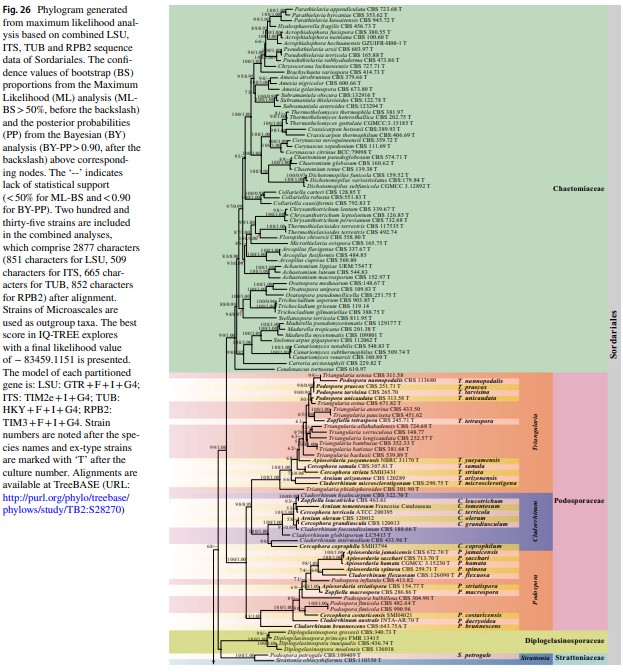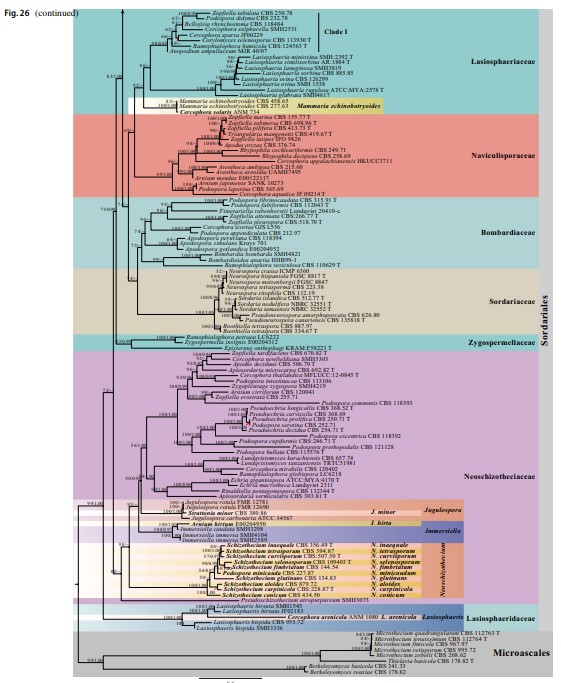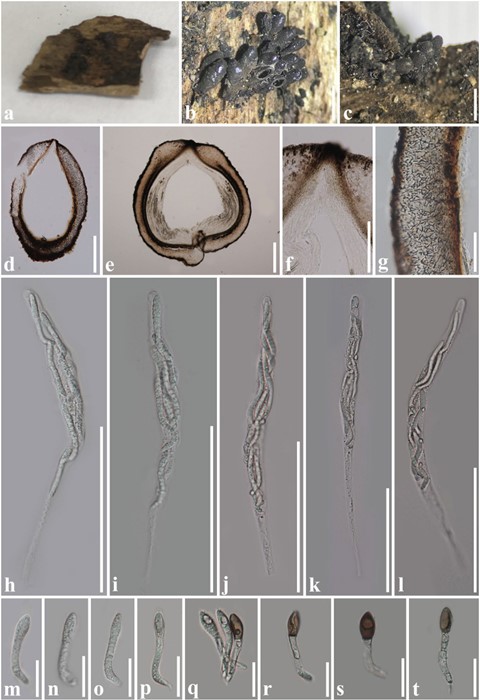Bombardia bombarda (Batsch) J. Schröt., in Cohn, Krypt.-Fl. Schlesien (Breslau) 3.2(1–2): 302 (1893)
Basionym: Sphaeria bombarda Batsch, Elench. fung. (Halle): 271 (1786)
Index Fungorum number: IF 119710, MycoBank number: MB 119710; Facesoffungi number: FoF 10016; Fig. 28
Saprobic on wood. Sexual morph: Ascomata 1–1.5 × 0.4–0.8 mm (x̄ = 1.2 × 0.6 mm, n = 5), perithecial, immersed to semi-immersed, gregarious, oval to subglobose, coriaceous, dark brown to black, glabrous, ostiolate papilla, with 2.5 µm wide periphyses. Peridium 75–120 µm (x̄ = 95 µm, n = 30) wide, coriaceous, comprising four layers, outer layer composed of amorphous brown to black material; middle layer composed of hyaline to brown cells of textura intricata, and dark brown, strongly tight cells of textura angularis; inner layer composed of pale brown to hyaline cells of textura prismatica. Paraphyses 2–3 µm wide, filiform, septate, evanescent. Asci (180–)200–260(–310) × 10–15 µm (x̄ = 230 × 12 µm, n = 30), 8-spored, unitunicate, ellipsoidal to cylindrical, pedicellate, apex rounded, with apical globule, evanescent. Ascospores bi-seriate, hyaline and cylindrical when young, upper cell becoming swollen to fusiform, brown, (10–)12–15 × 5–10 µm (x̄= 13.5 × 8 µm, n = 50), with an apical germ pore, sometimes with a tiny, hyaline, inconspicuous decoration on the apex; lower cell cylindrical, hyaline, (20–)24–30 × 3.5–6 µm (x̄ = 26 × 4.5 µm, n = 50), smooth-walled, guttulate, with a terminal conical appendage at the base, evanescent. Asexual morph: Undetermined.
Material examined: Italy, Veneto, Treviso, Cansiglio, on dead trunks of Fagus, October 1874, P.A. Saccardo (S-F750); Ukraine, Lvivska oblast, Stryi, riverbank near Wierzany, on stems of Alnus, 28 October 1916, F. Petrak (S-F753).
Known hosts and distribution: On dead, decorticated wood in Germany (type locality) (Saccardo 1882); on dead wood in Belgium, Denmark, England, Finland, France, Ger- many, Hungary, Italy, New Zealand, Poland, Russia, Sweden, UK, Ukraine and USA (Lundqvist 1972; Miller and Huhndorf 2005).
Notes: We re-examined authentic materials of Bombardia bombarda, F750 and F753, collected by Saccardo and Petrak, respectively. The molecular data of B. bombarda were provided (Miller and Huhndorf 2005; Spatafora et al. 2006), and in this study, B. bombarda (SMH4821) is sister to Bombardioidea anartia (HHB99-1) (100%ML/1.00PP, Fig. 26).



Fig. 2. Bombardia bombarda: a, b, d, g–i, m–p (S-F750); c, e, f, j–l, q–t (S-F753). a Her- barium material. b, c Ascomata on host. d, e Ascoma in cross-section. f Ostiole with periphyses. g Peridium. h–l Asci. m–t Ascospores. Scale bars: b–c = 1 mm, d–e = 200 µm, f. h–l = 100 µm, g = 50 µm, m–t = 20 µm
